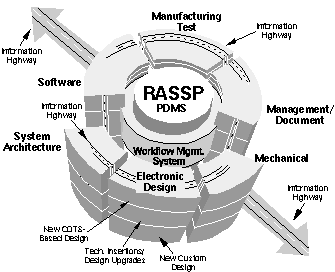Next: 2 Technology Description Up: Appnotes Index Previous:Appnote ENTERPRISE Index
![]()
![]()
![]()
![]()
Next: 2 Technology Description
Up: Appnotes Index
Previous:Appnote ENTERPRISE Index
Encapsulated with the Workflow Management System are multiple CAD tools used at various phases of the DSP system lifecycle - proposal phase through contract management, engineering design, purchasing, fabrication, and delivery to the customer.
Other enabling technologies associated with the RASSP Enterprise Framework include:
The RASSP Manufacturing Interface (RASSP-MI) developed by SCRA enables hardware designers to quickly and easily identify manufacturing issues at early phases of the design process (such as after completion of component layout). Using robust standards such as EDIF 400 and STEP ISO 10303 - 210, the RASSP-MI ensures that the requirements of predictability, completeness, consistency, and semantic correctness in the exchange of product data are met. In addition, producibility analyses can be performed during design phases - a capability not available previously.
To facilitate reuse in the engineering projects, the RASSP reuse data management system enables designers to efficiently search across multiple libraries in an organization in a uniform fashion, to identify and select design objects for reuse from a vast network of available sources. Capabilities to perform stand-alone tests of the selected design object, modify the design object if necessary, and integrate it into the current system are also supported.
Continuous improvement of an organization-s design processes is enabled through the collection and analysis of project metrics. As the design cycle of a DSP system proceeds, the Workflow Management System logs records for each task event. Records include start and finish times, user's identity, CAD tool information, task identification, and other engineering notes. A facility is provided for analysis of this metrics information in order to support identification and resolution of schedule and resource bottlenecks.
1.0 Introduction
The RASSP Enterprise Framework, summarized in figure 1- 1 was developed by Lockheed Martin Advanced Technology Laboratories (LM-ATL), in collaboration with Intergraph Corporation, Rockwell International Corporation, Mentor Graphics Corporation (MGC) and South Carolina Research Authority (SCRA). It is comprised of an extensive set of tools, all seamlessly integrated with a common desktop environment. At the core of the Enterprise Framework is the Product Data Management System (PDMS). The PDMS configuration manages all of the design data produced during the design cycle of a DSP system, and provides complete file tracking for documentation of the system configuration. Integrated with the PDMS is the Workflow Management System. The Workflow Management. System implements an organization's best design practices as repeatable workflow segments. These workflow segments are stored as templates and are attached to projects at project creation time. The Workflow Management System guides the user through the design process, using a graphical representation of the workflows, ensures that all critical steps in the process are followed, and provides access to the appropriate CAD tools and data at the proper times. The design process can be a simple upgrade to an existing design, a new COTS-based design, or a new custom design.
![]()
![]()
![]()
![]()
Next: 2 Technology Description
Up: Appnotes Index
Previous:Appnote ENTERPRISE Index